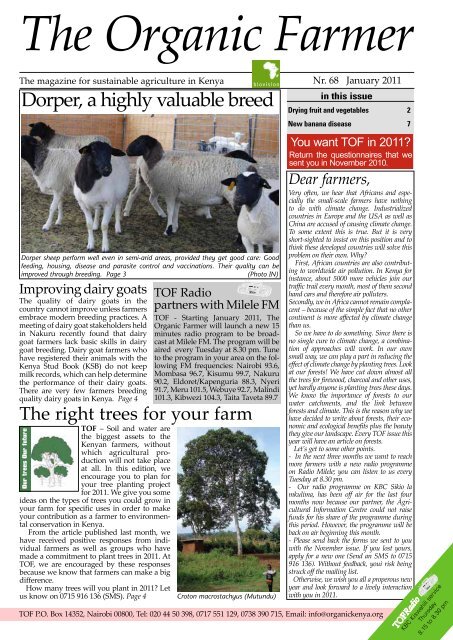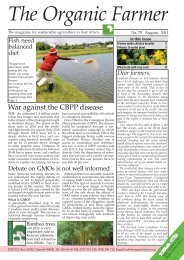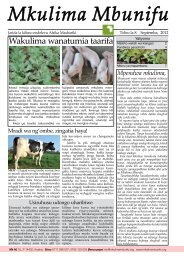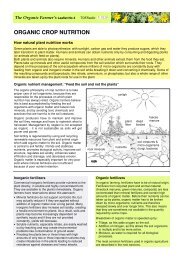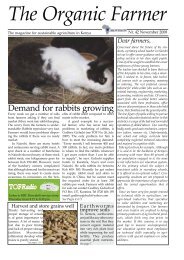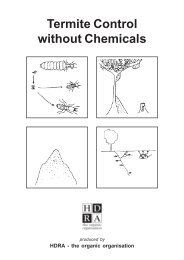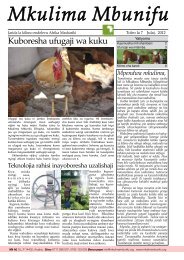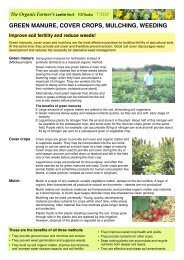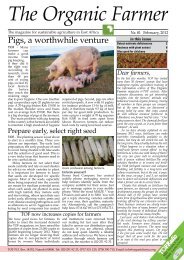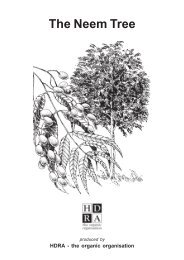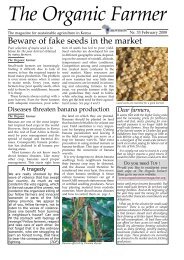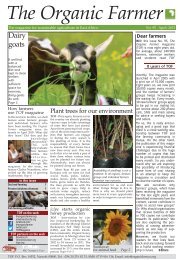Dorper, a highly valuable breed - Infonet-Biovision
Dorper, a highly valuable breed - Infonet-Biovision
Dorper, a highly valuable breed - Infonet-Biovision
Create successful ePaper yourself
Turn your PDF publications into a flip-book with our unique Google optimized e-Paper software.
Nr. 68 January 2011<strong>Dorper</strong> sheep have attractive properties<strong>Dorper</strong> sheep do well with goodfeeding, housing, disease and parasitecontrol and vaccinations.Theresa SzékelyExotic <strong>breed</strong>sand disease resistanceExotic animal <strong>breed</strong>s and their offspringare often less adapted to diseases,parasites, and poor nutritionand management levels. <strong>Dorper</strong>sheep, for example, are less resistantagainst gastro-intestinal parasites thanred Maasai sheep. This may result inhigh death rates in lambs, if dewormingis not carried out early and frequently.Because dorper sheep havebeen bred into local sheep herds quiteoften in the past, there is even a fearthat the natural disease resistance ofnative <strong>breed</strong>s may be weakened orlost due to uncontrolled cross-<strong>breed</strong>ing.It seems to be more and more difficultto find purebred red Maasaisheep in the country. A recent studycame to the conclusion that this native<strong>breed</strong> which is so well adapted toits environment may actually be it is especially important for regionswhere parasite numbers are high, e.g.in a coastal sub-humid climate.Breeding records are importantIt is absolutely essential that all farmerskeep a <strong>breed</strong>ing documentation foreach animal. This is the only measurethat can prevent in<strong>breed</strong>ing. In<strong>breed</strong>ingdegrades the health and performanceof all animals and ruins theeffect of upgrading. mate with its sisters, daughters, granddaughters,mother or grandmother.Compare the parents and grandparentsof any ewe you want to mate withThe dorper sheep is a cross-<strong>breed</strong> (an African <strong>breed</strong>) and the dorset horn(a British <strong>breed</strong>) developed in SouthAfrica between 1945 and 1950. It is avery successful and adaptable <strong>breed</strong>that has been exported to many countriesincluding Australia. The dorpersheep was introduced into Kenyaabout 50 years ago. There are twotypes: the ‘dorper’ with a black head,neck and legs, and the ‘White dorper’with a white head.<strong>Dorper</strong> sheep perform well in semiaridareas. They have a high lambingpercentage and can <strong>breed</strong> every 8months. They lamb easily, are excellentmothers, and have a quiet disposition.They are quite disease resistant and notsusceptible to fly strike. Lambs gainweight quickly, mature early and maybe mated at around 9 months.Good care is essentialThese are very attractive properties.However, if you would like to keepdorper sheep, you should not stopthere. There are some more importantfacts to consider. that they are hardy and adapted totheir environment and climate. RedMaasai sheep, for example, can copemuch better with worm infestations ordroughts than exotic <strong>breed</strong>s. It thereforemakes sense to give priority to theimprovement of local <strong>breed</strong>s. exotic <strong>breed</strong>s is only successful in combinationwith improved animal husbandry.Otherwise, exotic <strong>breed</strong>s maydo even worse than local <strong>breed</strong>s asthey require better management (seebox exotic <strong>breed</strong>s).and management. The most effectivestep to improve profitability of anysheep <strong>breed</strong> is to improve husbandry:Good feeding, housing, disease andparasite control and vaccinations. ewes do not come on heat, their milkproduction is poor and their lambs areweak and develop slowly. Clean sheds,clean water, sufficient quality feedsand supplements and mineral licks areessential. be improved further by a good <strong>breed</strong>ingprogramme. Select heavy animalsfor <strong>breed</strong>ing, as they produce fastergrowing offspring. For a lasting effectit is essential to prevent in<strong>breed</strong>ing(see box <strong>breed</strong>ing records) and to includeas many animals as possible. The bestway to do this is by involving thewhole community or region. grazers that feed close to the groundand will finish off a pasture entirely. Indry regions you should be careful withsheep: They may ruin the scarce andfragile vegetation completely.the parents of any ram you are goingto use.which allows you to identify each ofyour animals! You must know at leastthe mother and father, grandmotherand grandfather of each animal.longer than one year. among users and farmer groups tobring in fresh blood.Improving local <strong>breed</strong>sOnly the best ewes and rams in aherd and in the community shouldbe chosen for reproduction. Castratesurplus rams. Selection criteria can befast growth (in rams), good health,fertility and litter size (twins may beundesirable as they are usually weakerthan single lambs), etc. Local sheep<strong>breed</strong>s may improve considerablywithin a short time if herds are wellmanaged.Upgrading of dorper sheepLocal ewes (e.g. Maasai ewes) aremated with rams of a more productive<strong>breed</strong>, e.g. the dorper sheep. Theresulting crosses are then mated withnon-related males and females withthe same level of cross-<strong>breed</strong>ing (50% the local <strong>breed</strong> can be maintained inthis way.Studies found that dorper-red Maasaicrosses had much higher lamb survivalrates than pure dorper sheep.The highest productivity was found inanimals with 75% red Maasai blood.This level is achieved by crossing purered Maasai with pure dorper sheep,and crossing its offspring again withred Maasai sheep. These “backcrosses”have 75% red Maasai blood and 25%<strong>Dorper</strong> blood.Farmers’ questionMost farmers in the semi arid areas areinterested in raising dorper sheep. Pleasewrite an article on dorper sheep in one ofyour issues, 0722 698 499.
Training for farmers in i-TOF CentresIf a farmers’ group is interested in training,they should get in contact with ouri-TOF Centres directly. The followingare the regions where they are located,including their contact addresses:i-TOF Centre Western ProvinceLocation: Kamukuywa (near Kimilili)Extensionist: Alfred Amusibwa,Contact: 0724 331 456Email: itof7@ organickenya.orgNr. 68 January 2011Farmers get credit to buy dairy cowsVictoria Mutinda*In Kangundo and its environs, whichis my area of operation, farmers do nothave dairy animals. Soon after TOFmagazine carried a story about cowleasing in January 2010, many farmersstarted asking me how they couldbenefit from the service. Two farmersgroups were particularly interested;Mavuno Self Help Group and MatetaniDairy Farmers.I told them that they could form asavings group, save the money for awhile then approach a bank for a loan.I visited Equity Bank to check for themthe arrangement that would be mostsuitable. The main aim of the farmerswas to increase milk production forhome consumption and also for sale.To do this, I trained the farmers fromthe two groups on proper managementof dairy animals; feeding and recordkeeping.They got loansThe members saved with the bank,where each member saved up to Ksh3,000 in six weeks. They used thesesavings to guarantee each other for theloans they later took from the bank. 20members of Mavuno and 30 membersfrom page 5Goat <strong>breed</strong>ingter of the foundation goat), it is registeredwith KSB as an appendix.Pedigree stage: When the appendixcomes on heat, it is served with a differentGerman Alpine pedigree buck; adaughter produced by the appendix isnow called a pedigree. The farmer cancontinue the pedigree line by eitherserving them with pedigree bucks withparticular characteristics that they wantto introduce into their goats.3. Cross-<strong>breed</strong>ingA cross-<strong>breed</strong> goat is a combination ofa local <strong>breed</strong> with a foreign or exotic<strong>breed</strong>. For example, a farmer mightwant to serve their local goats withexotic <strong>breed</strong>s such as the Toggenburg.The offspring or daughter born of theof Matetani received loans rangingfrom Ksh 40,000 and Ksh 70,000 whichthey used to purchase dairy animals.Value addition trainingMilk production has improved asfarmers have put into practice theknowledge received from the training.I trained the committee memberson milk value addition and now theymake and sell mala or sour milk. Ofthe 7,000 litres of milk collected everymonth, 650 litres is converted to malafor sale to local customers.The farmersare improving their livelihoods as theyrepay the loan.*TOF Extensionist in Kangundoi-TOF Central ProvinceLocation: Gatuto/ KagioContact: 0724 331 375Email: itof2 @organickenya.orgi-TOF Eastern ProvinceLocation: Kangundo townExtensionist: Victoria MutindaContact: 0724 331 405Email:itof1@organickenya.org.two <strong>breed</strong>s is known as a cross<strong>breed</strong>or F1.To improve the cross, the F1 isagain served with another buckof the same <strong>breed</strong>, Toggenburg in thiscase. The resulting offspring is calledthe F2. The farmer can go further incross-<strong>breed</strong>ing by mating the F2 withanother F2 goat. The resulting <strong>breed</strong>is known as the ¾ crosses or a completelynew <strong>breed</strong> of goat that has noparticular characteristic of any <strong>breed</strong>.The ¾ cross can be mated with other¾ crosses until they reach the last stagecalled stabilization stage. The characterof the new goat <strong>breed</strong> is noted and astandard set by the KSB in preparationfor the registration of the new <strong>breed</strong>.Answers in briefTop dressDo you mean that we can use farmyard or compost manure only wedon’t top dress our crops with C.A.N.?Farm yard manure and compost areusually mixed into the soil beforeplanting. You may top dress with plantor manure tea in weak growing cropsor with diluted slurry (fermentedurine) or C.A.N. in heavy feeders.Sweet potatoesIs it true that we can obtain proteinsfrom sweet potato leaves?It is true: Young sweet potato leavesand shoots are rich in proteins, essentialvitamins and minerals. Sweetpotato leaves are consumed in manytropical countries all over the world.They can be prepared like any othervegetable.ProteinWhich animal meat has high proteins?All animal meat is rich in protein butsome sources are higher than otherse.g fish, beef, pork, turkey and rabbit.Leguminous plantsWhy is it advisable to use green leavesfrom high - protein leguminous treeswhen preparing compost manure?Young leaves and shoots of any plantare rich in proteins. If proteins decompose,nitrogen is released. This nitrogenis necessary for the bacteria thathelp decompose the compost material.Especially if you cannot provide freshanimal manures and urines which arealso rich in nitrogen, green plant materialwill be a good source of nitrogenthat will speed up the decompositionprocess. Leguminous plants are especiallyrich in protein and thereforea very good ingredient in compostmaking.TithoniaCan I boil Tithonia while makingplant Extract? (Lucy Wanjiku, Farmerin Kambirwa, 0717 225 315)You don’t need to boil Tithonia as thiswill destroy some substances that areimportant for a good fermentationprocess. One easy way of making aplant extract using tithonia is to choptithonia vegetative parts and soakthem in water at a ratio of 1 parts in4 parts of water. Let it stand for seven ratio of 1:1 to dilute the concentratedsolution before the application.InoculationCan seed inoculation be applied inmaize seeds during sowing? BernardKamau, farmer in GiikuniSeed inoculation is applied in legumesespecially when the crop is plantedfor the first time in the field. Inoculationmeans that the seeds are treatedwith a preparation of special bacteriathat enable the leguminous plants tofix nitrogen from the air. Maize plantsare not able to do this, so inoculatingmaize seeds will not have any effect.
Nr. 68 January 2011Two devastating banana diseasesThanks a lot Theresa for an elaborateanswer to my banana problem,which I am sure most farmers silentlyface. There is yet a devastating bananadisease which attacks after fruiting. Asfruits mature, they appear to ripen, butthen rot. Could you advise on remedialaction for affected farmers and helpus save this enterprising crop. GideonOchola 0722 298 699Thank you for your compliment. It istrue; there is yet another disease, orrather two diseases threatening bananaproduction in many African countries:banana bacterial wilt and banana both are extremely difficult to control.Banana bacterial wiltBacterial wilt causes wilting of leaves,uneven and premature ripening ofbunches, and fruit rot. The whole plantrots and dies eventually. This disease,also called Banana Xanthomonas Wilt(BXW), is spreading around the GreatLakes region including Kenya. Bananawilt cannot be treated by pesticides orbio-control agents. All banana cultivarsare susceptible, and naturally resistantvarieties do not exist. Control canonly be achieved through strict andimmediate eradication and destructionof infected plants. Removal of malebanana buds is important as this isthe primary infection site. Sterilizationof used tools and availability of cleanplanting material are also essential. Ifthese efforts are neglected, the diseasemay resurge, as experience docu-There is some hope that a transgenicbanana variety that carries a resistancegene from sweet pepper can contributeto the solution of the problem.However, this variety is still in developmentat IITA (International Instituteof Tropical Agriculture) and NARO(National Agricultural Research Orga-to be released.BBT diseaseThe other disease is banana bunchytop disease (BBTD) caused by the BBTvirus.It affects bananas worldwide andis present in 11 Sub Saharan countriesincluding Kenya. BBTD causes bunchedleaves at the top that are narrow andwavy with yellow margins. The plantsare stunted and fruitless and will diesoon. Newly infected plants cannot bedetected easily and the disease oftenspreads uncontrolled. The only controlmeasure is the removal and destructionof affected plants as soon as symptomsare noticed. In Australia, costly eradicationprograms and strict quarantinecontrol led to disease eradication, butthere is a high risk of resurgence. tszHow to clean drip irrigation pipesI am an organic farmer & use dripwater is salty & has blocked manyholes in the pipes. I have been advisedto use phosphoric or sulphuric acid. Isalso advise other methods I can use.0722 563 439sphoric and sulphuric acid areused to treat and reduce plugging ofdrip lines caused by mineral deposits(usually lime and magnesium). Theymay actually not be used in certifiedInside a drip pipe: Only clean water canrun out of the small holes shown (arrow);ensure the pipes are cleaned regularly.organic farming, but natural acids likeacetic acid (vinegar) or citric acid areallowed. They are more expensivebecause larger amounts are necessaryto achieve the same effect. Cloggingof emitters can also be caused by bacterialgrowth which is treated withchlorine or hydrogen peroxide. Thisis usually done at least once everymonth. Irrigation pipes should alsobe flushed thoroughly at least onceevery month. Filters must be checkedand cleaned at least once every week,or even every day if the water is dirty.This regular maintenance shouldnever be neglected, as clogged linesstop working and are very difficult torepair; they may have to be replaced. Incase of problems with the drip systemyou need qualified advice. Try to getinformation for your specific case fromyour irrigation equipment supplier,and from a local chemical dealer withrespect to chlorine and acid applications.Or you can get in contact withDavid Smith, david.dihelp@gmail.comor 0771 906 219Fungi on pawpawsI was given your magazine on 28.9.2010.plants. I have already planted 1000plant is turning yellow. I am a smallNjau Chomba, Box 196, Maragua, 0726695 429Turning yellow may be due to a numberto find out what is wrong with yourplants first. If there is no good extensionservice in your region, you mayfor instance go to an Internet café anduse <strong>Infonet</strong> (www.infonet-biovision.org). Click Crops/ fruits/ vegetables, Click on it, and you will find informationon pawpaw including on commonpawpaw diseases and on what to doabout them. Ask somebody for help ifyou are not used to using the internet!Controlling leaf minersI have planted courgette in my organicfarm and have problems with leafmin-James Muriithi, farmer in SaganaCheck the seedlings and older plantsfor abnormality. Neem extracts usefull:Apply them several times at weeklysolution which is effective against awider range of pests. Conserve naturalenemies like parasitic wasps whichkeep leaf miners under control.Bananas need a lot of waterHow many liters of water does onebanana plant require per day? Howmuch is this in relation to a plant tea tobe applied? Farmer in BuyanguBananas require a lot of water! Theyneed an amount of rain, which isequivalent to an average of 15 - 25 litersper plant every day of the year (if youcalculate an area of 5 square meters perplant). In hot and dry weather even upto 35 liters of water may be required.Applications of plant teas will thereforeonly contribute a small part of thenecessary water supply. But bananaswill be very grateful if you providesome water during dry spells. Waterdeficits have an adverse effect on plantgrowth and banana yields. A constantand good water supply is especiallyimportant during establishment ofyoung suckers and before flowering.We recommend mulching of bananas;this will conserve water, improve infiltrationand provide nutrients. tsz
TOF - We are getting quite a number ofquestions about dairy cows with retainedplacenta. That is the reason, why weanswer these questions immediately.1. What causes retained placenta orlong hours or placenta withdrawal in acalved down cow?2. Which plant can I use to give tomy cow in case of a retained placentaof calved down cow so that it comesout on time or quickly? Farmers inBuyanguRetained placenta is quite frequent,especially in dairy cows. It can have anumber of reasons and often indicatesNr. 68 January 2011 020 445 03 98 0717 551 129 0738 390 715What to do with retained placentathat other health problems exist.common causes. Cows that abort, calveprematurely, have twins, or any otherdifficulties or illness during calvingare more likely to suffer from retainedplacenta. The reason behind this is thatthe uterus can easily become infectedwhen there are calving problems andwhen the immune system is weakened. a high risk for retained placenta andinfections of the reproductive tract. Vitamin and mineral deficiencies canmake the cow <strong>highly</strong> susceptible touterine health problems. Overweightcows have also an increased risk ofretained afterbirth. and leptospirosis can induce earlycalving and cause retained placenta.Milk fever can also be associated withretained placenta.PreventionMany cases of retained placenta can beprevented. The best thing is to maintaina healthy, well-fed and active cowbefore, during and after calving. Takecare to give a balanced ration duringthe dry period. Daily exercise (e.g.grazing) is important, because a weakcow that is not used to exercise (e.g. acow that is kept in a zero-grazing unit)is more likely to have difficulties atcalving. The calving area must be large,comfortable and very clean to reducethe chances of placenta retention andinfections of the reproductive tract.What you can do?We are sorry not to be able to recommendplants that can be helpful, but wecan offer the following advice.Retained placenta has in the past beentreated by removing it manually. Thispractise has been abandoned, becausethere is a high risk of internal injurieswhich may even lead to infertility. Theplacenta should be allowed to separatenaturally, even if it takes a whole week.You should also resist the temptation tocut any hanging material off, becausethe rest may suck back inside the cow,introducing bacteria that will cause aninfection.If the cow shows signs of infection(fever, depression, lack of appetite) aveterinarian should be consulted.It is also recommended to leave thecalf with the mother. Frequent nursingcauses release of hormones that stimulatethe release of the placenta.Sexed semen now available in KenyaHow can I serve my cow to eithercome up with a male or a female calfdepending on my own choice? Farmerin BuyanguYou are expressing an old wish ofcattle <strong>breed</strong>ers. Beef producers willprefer male calves, while dairy producersneed female calves for restocking.that are difficult to influence. Thereason for this is simple: The semenliquid of the bull (in fact of any malecreature) contains a mixture of 50%male sperms and 50% female sperms.In industrial countries, methods areunderway to separate the semen intomale and female sperms (“spermsexing”) for artificial insemination.However, the procedure is expensiveand challenging technically, andthe separated semen is more difficultto handle and pregnancy rates arelower. Sexed semen is now available inKenya. We have not heard of any othermethods that are successful and reliablein selecting the sex of the animals.Make your own fertilizer!Farmers in Central Kenya have beenspending a lot of money buying farmyardmanure from pastoralists in parts of RiftValley to improve their depleted soils.However, the quality of the manure hasnot been up to standard: It is left in theopen cattle boma where it is exposed tosunlight and rain, which wash away allthe essential nutrients such as nitrogen.Farmers who use such farmyard manureget very low crop yields.Use on-farm resourcesSince the crops can no longer do wellwithout fertilizer or manure, farmers needto look for alternative methods of restoringsoil fertility. They should look for resourceswithin their farms to prepare good qualityfertilizers. One of the methods they canadopt is the preparation of compostmanure or even liquid manures (see TOFNr. 44 January 2009 and Nr.47 April 2009). The material for preparation of compostis readily available on the farm and wouldsave the more than Ksh 20,000 farmers payfor one lorry-load of poor quality farmyardmanure.The government should make use of itsextension workers to train farmers to useavailable resources within their farms tomake organic fertilizers such as compostand liquid manure to improve soil fertilityand increase food production.Eutycus Muchiri. P.O.Box 543, Othaya, 0725320 115Stop over-reliance on maize!Whenever the weather is good and there isoverproduction of maize, the natural lawsof supply and demand come into play.Buyers offers very low prices, sometimesfar below the production price. As if thisis not bad enough, the pests and aflatoxintrouble the farmers even more.Imported maizeDuring bad weather as drought, the shortfallin production is replaced by cheapmaize, imported by greedy cartels, whilethe farmers do not benefit from enhancedprices that come with the shortage.There are two issues here that the farmersmust tackle to alleviate incurring accumulateddeficit every year:High production cost: Farmers shouldconvert to conservation tillage coupledwith organic farming. At least this willreduce production cost.Diversify: I guess that where maize grows,there are other crops, which can also dowell. Farmers should grow them to optimisetheir income. Looking at it closely,the maize farmers are subsidizing the ugaliconsumers without getting anything inreturn. This season I have seen a lot offarmers sell green maize to get higherprices, but this will also create food securityproblems in some homesteads.For the last four years, I have not grownmaize for commercial purpose. I haveinstead grown fruits and a little maize formy own use and it has not been bad forme. Farmers should wake up!Karimi, farmer


